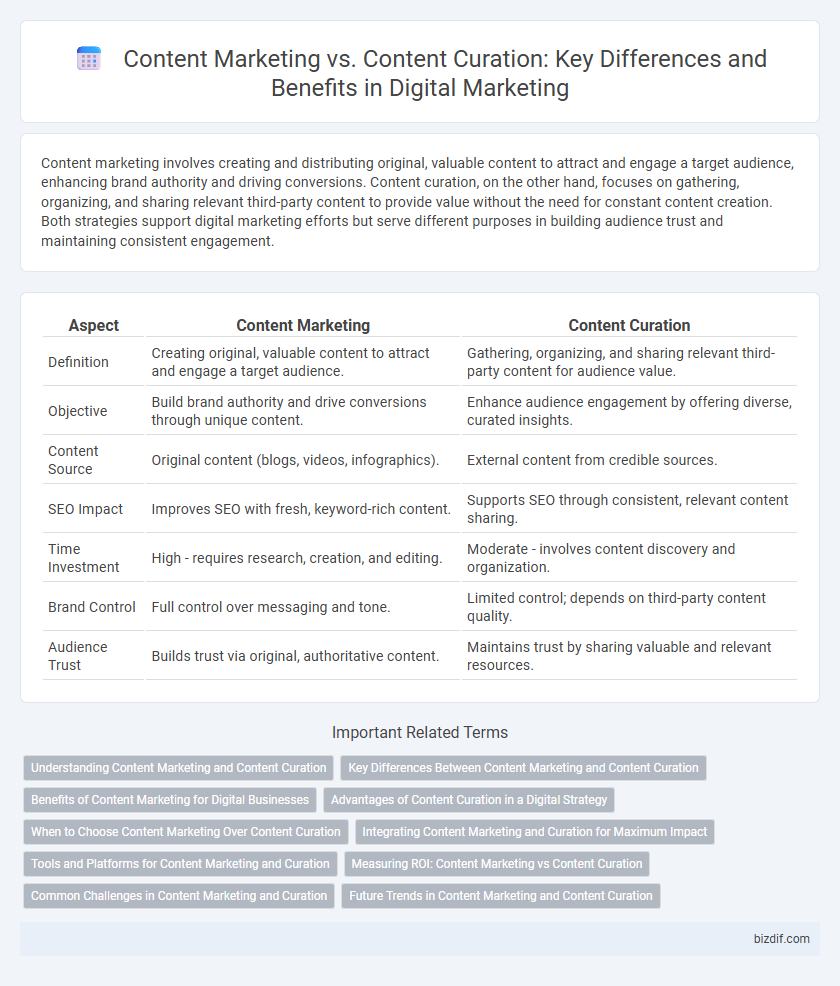Content marketing involves creating and distributing original, valuable content to attract and engage a target audience, enhancing brand authority and driving conversions. Content curation, on the other hand, focuses on gathering, organizing, and sharing relevant third-party content to provide value without the need for constant content creation. Both strategies support digital marketing efforts but serve different purposes in building audience trust and maintaining consistent engagement.
Table of Comparison
| Aspect | Content Marketing | Content Curation |
|---|---|---|
| Definition | Creating original, valuable content to attract and engage a target audience. | Gathering, organizing, and sharing relevant third-party content for audience value. |
| Objective | Build brand authority and drive conversions through unique content. | Enhance audience engagement by offering diverse, curated insights. |
| Content Source | Original content (blogs, videos, infographics). | External content from credible sources. |
| SEO Impact | Improves SEO with fresh, keyword-rich content. | Supports SEO through consistent, relevant content sharing. |
| Time Investment | High - requires research, creation, and editing. | Moderate - involves content discovery and organization. |
| Brand Control | Full control over messaging and tone. | Limited control; depends on third-party content quality. |
| Audience Trust | Builds trust via original, authoritative content. | Maintains trust by sharing valuable and relevant resources. |
Understanding Content Marketing and Content Curation
Content marketing involves creating original, valuable content tailored to engage a specific audience and drive brand awareness, while content curation focuses on discovering, organizing, and sharing relevant third-party content to provide value and context. Understanding the distinct roles of content marketing and content curation helps businesses balance originality with resource efficiency, maximizing audience engagement and trust. Effective digital marketing strategies integrate both approaches to enhance content diversity and foster stronger customer relationships.
Key Differences Between Content Marketing and Content Curation
Content marketing involves creating original, targeted content to attract and engage a specific audience, while content curation focuses on gathering, organizing, and sharing existing content to provide added value and insights. Key differences include content ownership, with marketing requiring proprietary content creation and curation depending on external sources. Content marketing drives brand messaging and conversion goals, whereas content curation emphasizes thought leadership and resource sharing in digital marketing strategies.
Benefits of Content Marketing for Digital Businesses
Content marketing drives long-term brand awareness by creating original, valuable content tailored to target audiences, leading to increased customer engagement and loyalty. It enhances SEO efforts by generating unique, keyword-rich material that boosts organic search rankings and website traffic. By positioning businesses as industry experts, content marketing helps build trust, nurture leads, and convert prospects into paying customers effectively.
Advantages of Content Curation in a Digital Strategy
Content curation streamlines digital marketing by efficiently aggregating relevant, high-quality content that resonates with target audiences, enhancing brand authority without the extensive resource demands of original content creation. It enables marketers to maintain consistent posting schedules while offering diverse perspectives, which boosts engagement and fosters community trust. Leveraging curated content also supports SEO efforts by increasing backlink opportunities and improving content relevance across multiple platforms.
When to Choose Content Marketing Over Content Curation
Content marketing is the preferred strategy when your goal is to build a unique brand voice and establish authority through original materials such as blog posts, videos, and infographics. Opt for content marketing when you need to target specific customer pain points with tailored messaging that drives conversions and SEO rankings. Relying solely on content curation often lacks the depth and exclusivity required to foster long-term audience engagement and brand loyalty.
Integrating Content Marketing and Curation for Maximum Impact
Integrating content marketing and content curation enhances digital marketing effectiveness by combining original content creation with the strategic sharing of relevant third-party resources. This approach boosts audience engagement, improves SEO rankings, and establishes brand authority by providing diverse, valuable information. Leveraging data analytics to identify trending topics ensures curated content complements original content, maximizing reach and impact across multiple platforms.
Tools and Platforms for Content Marketing and Curation
Content marketing relies heavily on platforms like HubSpot, SEMrush, and WordPress for creating, distributing, and analyzing original content aimed at engaging target audiences. Content curation tools such as Scoop.it, Curata, and Feedly streamline the process of discovering, organizing, and sharing relevant third-party content to add value and maintain audience interest. Leveraging these specialized tools enhances efficiency and effectiveness in both crafting original messages and curating existing content to support broader digital marketing strategies.
Measuring ROI: Content Marketing vs Content Curation
Measuring ROI in content marketing involves tracking metrics such as lead generation, conversion rates, and customer engagement to evaluate the effectiveness of original content in driving business growth. Content curation's ROI measurement focuses on audience retention, social shares, and time spent on curated content, highlighting its role in building brand authority without extensive content creation costs. Both strategies require analytics tools like Google Analytics and social media insights to quantify impact and optimize future campaigns.
Common Challenges in Content Marketing and Curation
Content marketing and content curation face common challenges such as maintaining consistent quality, ensuring original value, and keeping audiences engaged amid information overload. Both strategies require continuous research to identify trending topics and relevance to target demographics while avoiding content fatigue. Efficient time management and resource allocation further complicate the balance between creating original content and curating external sources.
Future Trends in Content Marketing and Content Curation
Future trends in content marketing emphasize personalized, AI-driven strategies that generate original, high-quality content tailored to specific audience segments. Content curation will increasingly leverage advanced algorithms and machine learning to efficiently aggregate relevant third-party content, enhancing user engagement without the overhead of creating new material. Both approaches will converge through hybrid models, combining authentic storytelling with data-driven curation to maximize reach, relevance, and ROI in digital marketing campaigns.
Content Marketing vs Content Curation Infographic

 bizdif.com
bizdif.com